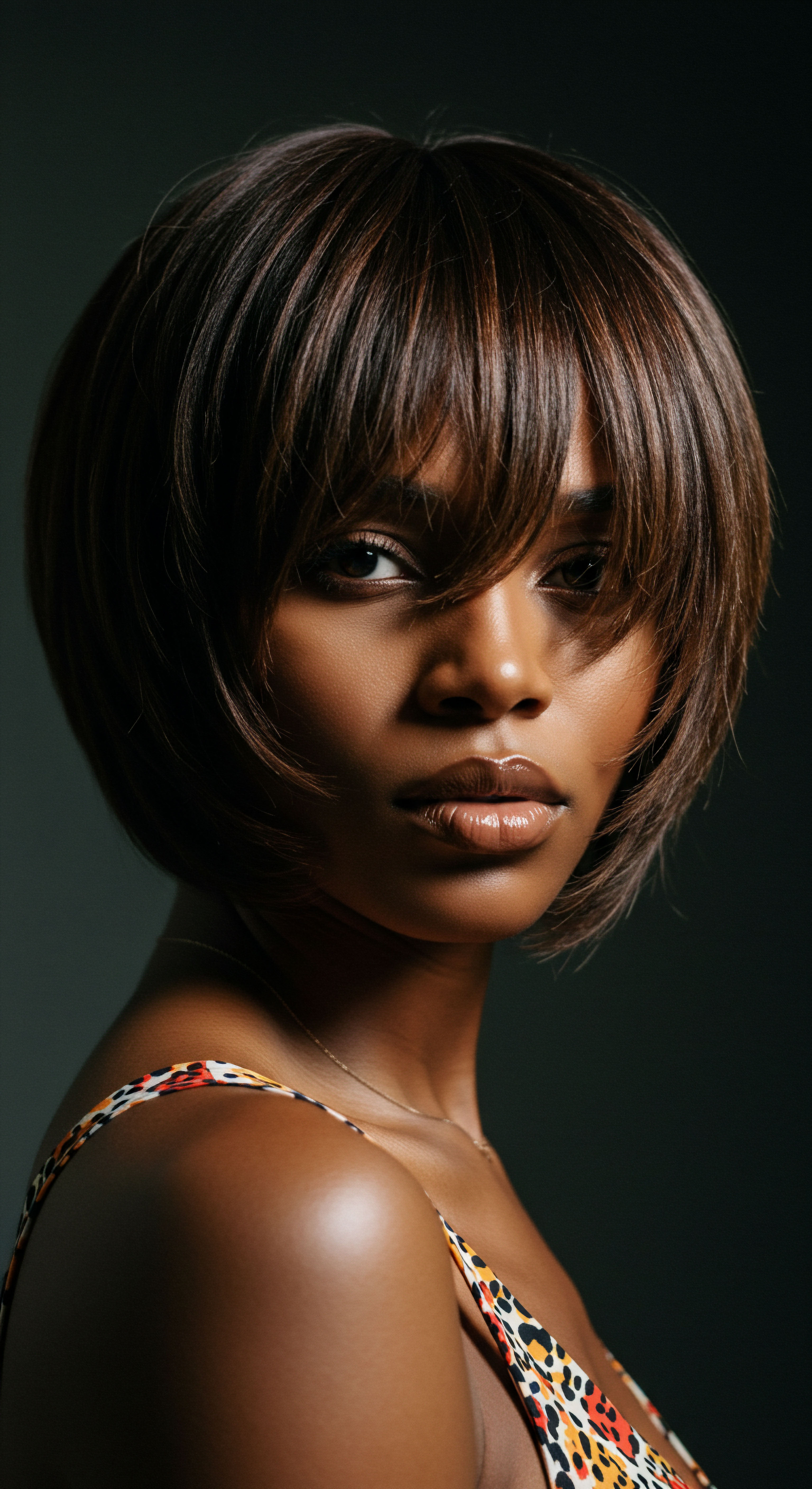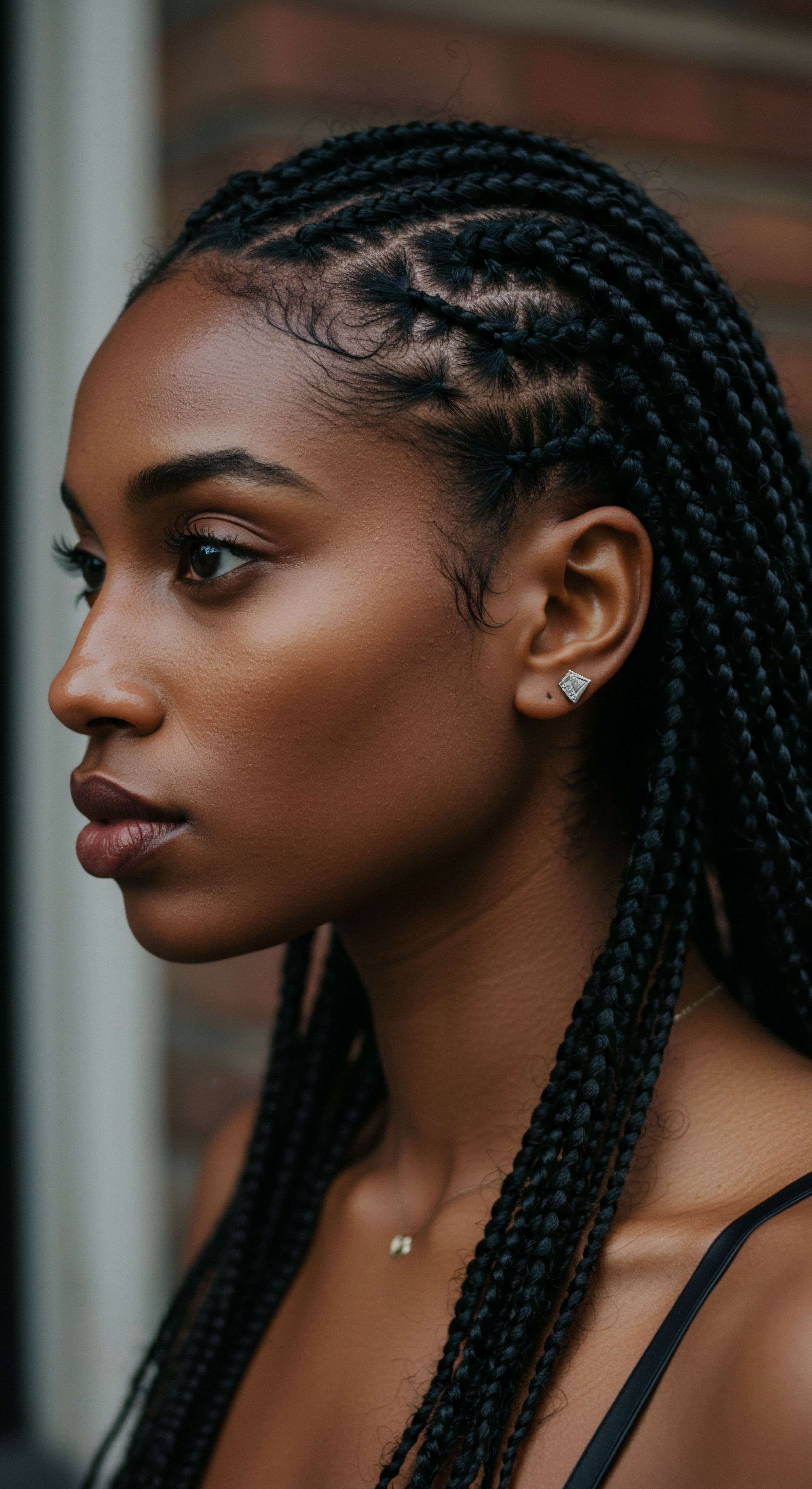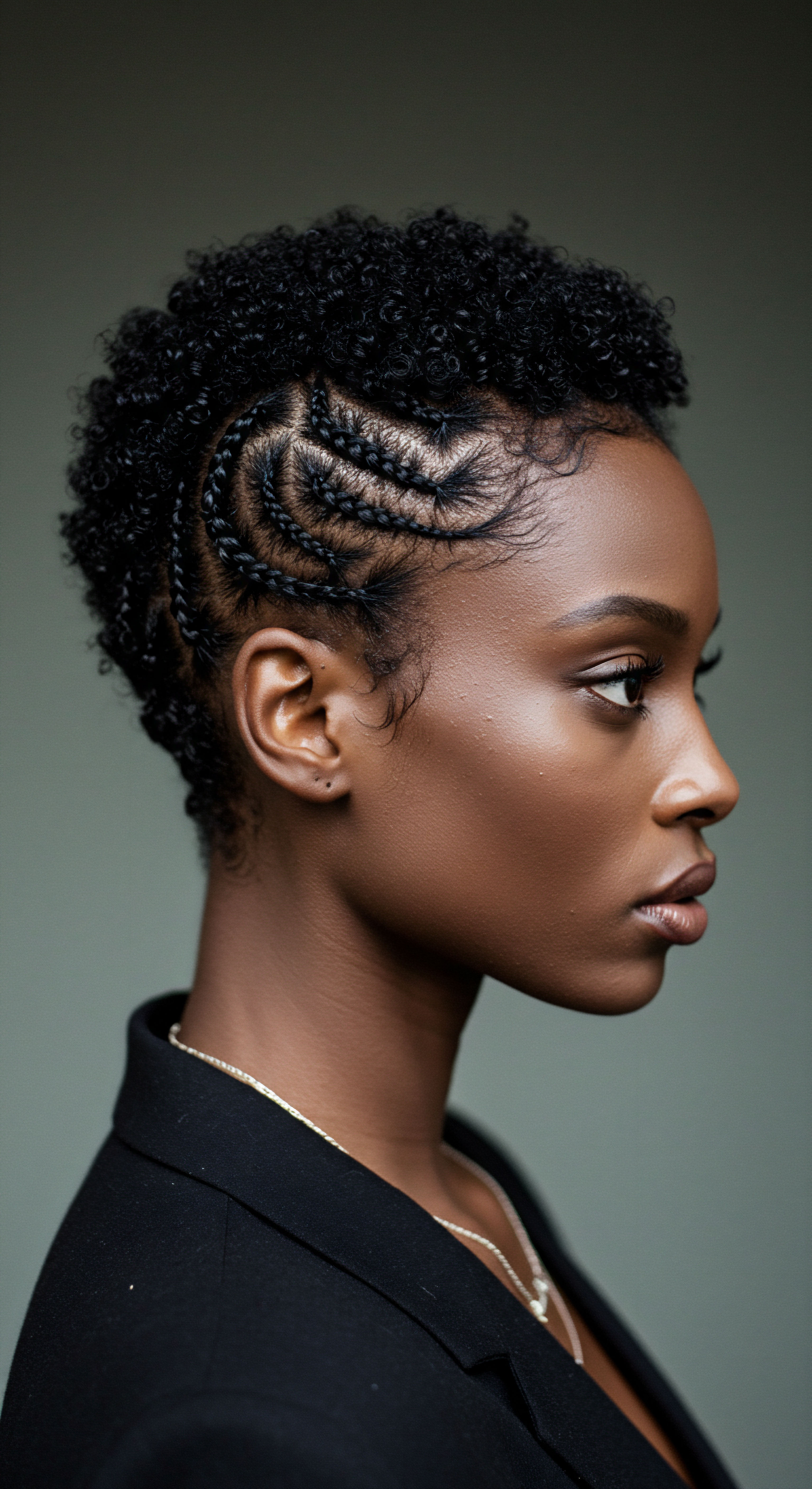
Roots
The quiet hum of our scalp, often unheard amidst the clamor of daily life, holds profound secrets to our hair’s vitality. For generations, wisdom keepers across cultures have understood this connection, recognizing that the scalp, much like fertile earth, must receive careful attention for anything to truly flourish. We stand at a threshold, looking back at ancestral practices while gazing forward into scientific discovery, seeking to understand if the time-honored traditions of hair care truly possess the power to mend and soothe our scalp conditions in a way that feels inherently right, inherently natural. This journey begins with a deep appreciation for the biological artistry that lies beneath our strands.

The Scalp’s Living Landscape
The scalp, far from being a mere foundation for hair, is a complex, dynamic ecosystem. It is skin, yes, but skin with unique characteristics, home to a dense population of hair follicles, sebaceous glands, and a distinct microbial community. Understanding this intricate environment is the first step toward genuine care. The skin of the scalp is thicker than elsewhere on the body, offering a robust protective barrier.
Its sebaceous glands are more numerous and active, producing sebum, a natural oil that coats the hair shaft and forms a protective film on the skin. This lipid-rich environment influences everything from pH balance to microbial composition.
The microbial community residing on the scalp, often referred to as the scalp microbiome, plays a significant role in its health. This delicate balance of bacteria, fungi, and other microorganisms acts as a shield, guarding against unwelcome pathogens and contributing to the overall stability of the scalp’s ecosystem. When this harmony is disrupted, a state known as dysbiosis, issues like irritation, dryness, and flaking can arise. Recent research highlights a strong connection between a disrupted scalp microbiome and various forms of hair loss, such as androgenic alopecia and telogen effluvium.
A 2021 clinical trial published in Experimental Dermatology found that 73% of alopecia patients exhibited decreased levels of beneficial bacteria like Cutibacterium Acnes, while harmful yeast such as Malassezia Restricta increased. This shift in microbial balance can trigger inflammation and follicular stress, potentially accelerating hair loss.

How Does Hair Grow From the Scalp?
Hair growth is a fascinating biological process, cyclical in nature, originating from the hair follicle, a tiny organ nestled within the scalp’s dermal layer. Each follicle undergoes distinct phases:
- Anagen Phase This is the active growth period, lasting from two to seven years, during which hair cells rapidly divide and keratinize, pushing the hair shaft upwards.
- Catagen Phase A brief transitional period, typically two to three weeks, where the hair follicle shrinks, and hair growth ceases.
- Telogen Phase The resting phase, lasting around three months, where the old hair prepares to shed.
- Exogen Phase The shedding phase, where the old hair falls out, making way for new hair to begin its anagen phase.
Disruptions to this cycle, often caused by inflammation, stress, nutritional deficiencies, or imbalances in the scalp environment, can lead to concerns like excessive shedding or thinning. Traditional practices, often working synergistically, aim to support these natural cycles by nurturing the scalp’s foundational health.

A Lexicon for Scalp Well-Being
To discuss scalp health with clarity, a shared understanding of terms is beneficial. Here are some fundamental concepts:
- Sebum The natural oil produced by sebaceous glands, crucial for lubricating hair and skin.
- Dandruff A common scalp condition characterized by flaking, often linked to an overgrowth of the yeast Malassezia, which thrives on sebum.
- Scalp Barrier Function The outermost layer of the scalp’s skin, which protects against irritants, allergens, and moisture loss.
- Inflammation The body’s natural response to injury or irritation, which, when chronic on the scalp, can impede hair growth and cause discomfort.
- Folliculitis Inflammation of the hair follicles, often caused by bacterial or fungal infection.
A well-balanced scalp is neither overly oily nor excessively dry. It is a harmonious environment where the natural processes of shedding and renewal occur without noticeable irritation or discomfort.
The scalp is a dynamic ecosystem, its health intricately linked to a balanced microbiome and the harmonious rhythm of hair growth cycles.

Ritual
Moving beyond the fundamental understanding of the scalp, we arrive at the practical wisdom of traditional hair care practices. Here, the essence of daily or periodic applications unfolds, revealing how time-honored techniques can gently guide the scalp back to its natural equilibrium. This section steps into the realm of shared, actionable knowledge, exploring methods that have nurtured textured hair for centuries, offering guidance with a soft, knowing touch.

The Practice of Scalp Oiling
One of the most enduring traditional practices, especially within South Asian and African cultures, is scalp oiling. This ritual involves applying oils to the scalp and massaging them in, a practice often passed down through generations. Oils like coconut, sesame, and moringa have been used for their purported benefits.
Coconut oil, for instance, is highly regarded for its ability to penetrate the hair shaft due to its low molecular weight and affinity for hair protein, helping to reduce protein loss from both damaged and undamaged hair. Sesame oil, rich in vitamins and minerals, offers deep conditioning and possesses antibacterial and antifungal qualities that may help manage dandruff.
The gentle act of massaging the oil into the scalp is as significant as the oil itself. This mechanical stimulation is believed to enhance blood circulation, ensuring that hair follicles receive essential nutrients and oxygen. Studies indicate that scalp massage can increase blood flow to the hair follicles, which is vital for maintaining healthy hair growth cycles. This increased circulation can also help reduce stress levels, a known contributor to hair shedding, by promoting relaxation.
| Oil Type Coconut Oil |
| Traditional Use Nourishing, conditioning |
| Potential Scalp Benefit Reduces protein loss, antifungal properties, deep conditioning |
| Oil Type Sesame Oil |
| Traditional Use Frizz reduction, conditioning |
| Potential Scalp Benefit Antibacterial, antifungal, deep conditioning, reduces dryness |
| Oil Type Moringa Oil |
| Traditional Use Dandruff reduction |
| Potential Scalp Benefit Helps reduce dandruff, makes hair soft |
| Oil Type Jaborandi Oil |
| Traditional Use Hair growth, dry scalp |
| Potential Scalp Benefit Nourishes dry scalp, may prevent dandruff |
| Oil Type These oils, used in traditional practices, offer diverse advantages for scalp well-being. |

Herbal Cleansers and Their Gentle Touch
Traditional cleansing methods often relied on plant-based ingredients that offered a gentler approach than many modern synthetic surfactants. Plants rich in saponins, natural foaming agents, have been used for centuries to cleanse hair and scalp. Examples include Sapindus Mukorossi (Soapnut or Reetha) and Acacia Concinna (Shikakai), traditionally used in India. These natural cleansers provide lather and are thought to offer advantageous effects on the skin, without stripping away the scalp’s natural oils.
Shikakai, specifically, is recognized for its antifungal, antibacterial, and mild cleansing qualities, attributed to its saponins, flavonoids, and fatty acids. Research suggests that Shikakai can inhibit enzymes related to inflammatory pathways and prevent the growth of various fungal species by interfering with their cell wall creation. Similarly, African black soap, crafted from plantain skin ash, cocoa pods, shea bark, and nourishing oils, is a traditional West African cleanser. Its natural antibacterial properties have been shown to work against certain harmful bacteria, making it a valuable tool for addressing issues like dandruff.

Can Regular Scalp Massage Truly Improve Scalp Health?
The simple, rhythmic act of scalp massage, deeply rooted in systems like Ayurveda and Traditional Chinese Medicine, is more than just a relaxing gesture. It is a deliberate practice aimed at invigorating the scalp’s underlying systems. Research indicates that regular scalp massage can indeed increase hair thickness. In one study, hair thickness increased in nine males after receiving a four-minute scalp massage once daily for 24 days.
Researchers proposed that mechanical stress on the cells of the hair follicles, specifically dermal papilla cells, stimulates the follicles to produce thicker hair. A separate study, based on self-reported results from 340 participants with androgenetic alopecia, found that about 69% noted improved hair regrowth after performing two 20-minute scalp massages daily for at least six months.
This mechanical stimulation also contributes to better blood circulation, ensuring that hair follicles receive the oxygen and nutrients necessary for optimal growth. Beyond the physical benefits, scalp massage can also reduce stress, which is a known factor in hair loss conditions such as telogen effluvium. By promoting relaxation and the release of feel-good hormones, the indirect impact on follicular health can be substantial.
Time-honored practices like scalp oiling and herbal cleansing offer gentle, yet potent, pathways to nurturing the scalp’s innate balance.

Relay
As we delve deeper into the interplay between traditional wisdom and modern understanding, the question of whether traditional hair care can naturally improve scalp conditions takes on a richer, more complex dimension. This section invites a profound exploration, where the scientific lens meets cultural intelligence, revealing the intricate mechanisms by which ancestral practices influence our scalp’s well-being. We move beyond simple applications to consider the interconnected biological, psychological, and social factors that shape our hair health journey.

Beyond the Surface Cleansing ❉ The Microbiome Connection
The scalp microbiome, that bustling community of microorganisms on our skin, is increasingly recognized as a cornerstone of scalp health. Traditional cleansing methods, often employing plant-derived saponins, typically possess a milder action compared to harsh synthetic sulfates found in many conventional shampoos. While modern surfactants can strip away protective oils and disrupt the delicate microbial balance, creating an environment where harmful microbes like Malassezia fungi can thrive, traditional alternatives tend to be less disruptive.
For instance, the use of African black soap, with its naturally alkaline pH (9-10), presents an interesting case. While the scalp thrives at a slightly acidic pH (4.5-5.5), this traditional cleanser, when used thoughtfully, can effectively lift stubborn product buildup and excess oil without the harsh stripping often associated with synthetic detergents. Its rich plant compounds, including polyphenols and minerals from plant ash, may play a supportive role in maintaining a balanced scalp microbiome and overall scalp health. The antimicrobial properties of African black soap have been documented, showing effectiveness against certain bacteria, which could contribute to a healthier scalp environment.
Consider the broader context of indigenous plant uses. Ethnobotanical studies from various regions, including India and Morocco, document dozens of plant species traditionally employed for hair and scalp care, addressing issues like dandruff, hair loss, and inflammation. Many of these plants, such as Arctium Lappa (Burdock) and Centella Asiatica (Gotu Kola), possess anti-inflammatory and antioxidant properties, which are crucial for protecting hair follicles from damage and maintaining scalp health. These botanical extracts often work by regulating inflammatory pathways and supporting the growth of beneficial microbiota on the scalp.

The Hormonal and Inflammatory Landscape
Scalp conditions are not always localized issues; they can be reflections of deeper internal imbalances, including hormonal fluctuations and systemic inflammation. Traditional medicine systems, such as Ayurveda and Traditional Chinese Medicine (TCM), often approach hair and scalp health from a holistic perspective, recognizing the interconnectedness of bodily systems.
In Ayurveda, hair loss and scalp disorders are often linked to imbalances in the body’s ‘doshas’ (energetic principles) and ‘impure blood’. Ayurvedic treatments frequently incorporate herbs that purify the blood, balance doshas, and possess anti-inflammatory and antimicrobial properties. A case report on the management of scalp psoriasis through Ayurveda, for example, highlighted the use of compounds like Panch Nimba Churna (purifying) and Rasa Manikya (antimicrobial), alongside other formulations, to reduce scaling and inflammation.
Similarly, TCM views hair health as a reflection of the strength of ‘Qi’ (vital energy) and ‘Blood’. Conditions like hair loss are often attributed to deficiencies in Kidney and Liver Qi and Blood. TCM practitioners utilize herbal decoctions and external applications to nourish Blood, regulate Qi, and improve blood flow to the scalp, thereby stimulating hair follicles. Scalp acupuncture, a modern acupuncture technique rooted in TCM principles, has been shown to improve blood vessel elasticity and increase cerebral blood flow, which is essential for combating blood stagnation and stimulating hair follicles.
A meta-analysis of randomized controlled trials found that scalp acupuncture significantly improved symptoms in children with cerebral palsy, including mental and motor abilities, by influencing cerebral blood flow and neural pathways. While this study focuses on neurological conditions, the underlying mechanism of improved blood flow to the head region underscores the potential physiological impact on scalp health.

A Surprising Revelation on Hair Shedding
While many contemporary hair care products promise to improve hair health, some may inadvertently contribute to scalp issues and hair shedding. A study published in Practical Dermatology revealed that traditional hair care products, often those with harsh surfactants or comedogenic ingredients, can deposit residue on the scalp, face, and back. This residue can remain on the skin for hours, contributing to acne, irritation, allergic contact dermatitis, dry scalp, and even hair loss.
The study further suggested that the use of milder surfactants might benefit epidermal barrier function, as harsh surfactants can repeatedly damage the stratum corneum permeability barrier and promote flaking. In a specific observation from this research, a change to hair care products avoiding common allergens and formulated with anti-inflammatory ingredients resulted in a significant reduction in hair shedding. Participants experienced 221 Fewer Hairs Shed Per Week compared to a control group, which extrapolates to over 11,000 fewer hairs lost annually. This compelling data point suggests that simply altering the chemical burden on the scalp, aligning more with the gentle philosophy of traditional care, can have a profound, measurable impact on hair retention.
Traditional approaches offer more than surface remedies; they address underlying imbalances and protect the scalp’s delicate microbial environment.

The Synergy of Mind, Body, and Scalp
Traditional practices often emphasize a holistic approach, recognizing that physical health, mental well-being, and environmental factors are deeply interconnected with scalp conditions. Stress, for example, is a well-documented contributor to hair loss, and traditional rituals like scalp massage often serve a dual purpose of physical stimulation and mental relaxation. The consistent, mindful application of natural remedies can become a meditative practice, reducing stress hormones and fostering a sense of calm that indirectly benefits the scalp.
Furthermore, dietary considerations, a cornerstone of traditional health systems, play a direct role in hair and scalp vitality. Nutritional deficiencies can weaken hair and compromise scalp health. Many traditional remedies are rich in vitamins, minerals, and antioxidants, providing systemic support that reflects in healthier hair and a more resilient scalp. The wisdom passed down through generations often encompasses not just external applications, but also an understanding of internal balance as the ultimate source of radiant health.

Reflection
As we step back from this exploration, a gentle truth emerges ❉ the whispers of traditional hair care, often dismissed in our fast-paced world, carry profound insights for scalp well-being. These ancient ways, born from generations of observation and natural attunement, offer more than just superficial solutions. They invite us into a dialogue with our own biology, encouraging a patient, mindful approach that respects the scalp’s inherent rhythms and its delicate ecosystem. The convergence of historical wisdom and contemporary science reveals a compelling story, one where the soft touch of ancestral remedies can indeed coax our scalp back to a state of natural serenity, fostering an environment where textured hair can truly thrive.

References
- Mouchane, A. et al. “Ethnobotanical Survey of Medicinal Plants used in the Treatment and Care of Hair in Karia ba Mohamed (Northern Morocco).” ResearchGate, 2024.
- Giri, A. et al. “An Ethnobotanical Study of Medicinal Plants Traditionally Used for Treatment of Hair Problems in Nuapadhi Village from Baleswar.” Indiana Publications, 2024.
- Chakraborty, A. et al. “Medicated hair oil formulation and positive effect on dandruff control with hair growth.” Indian Journal of Traditional Knowledge, 2022.
- Kishore, P. et al. “An Ayurvedic approach in the Management of Darunak (Dandruff) -A Review.” Natural Volatiles & Essential Oils, 2021.
- Guo, J. et al. “Therapeutic effect of scalp-based acupuncture and moxibustion as an adjunctive treatment on children with cerebral palsy comparing to conventional rehabilitation therapy ❉ a systematic review and meta-analysis of randomized controlled trials.” Translational Pediatrics, 2022.
- Okano, H. et al. “Standardized Scalp Massage Results in Increased Hair Thickness by Inducing Stretching Forces to Dermal Papilla Cells in the Subcutaneous Tissue.” Dermatology and Therapy, 2016.
- Al Badi, K. et al. “Hair Care Cosmetics ❉ From Traditional Shampoo to Solid Clay and Herbal Shampoo, A Review.” MDPI, 2019.
- Tao, X. et al. “Clinical efficacy of a combination treatment of traditional Chinese medicine for scalp seborrheic dermatitis.” Journal of Cosmetic Dermatology, 2023.
- Ruksiriwanich, K. et al. “REVIEW ❉ THE POTENTIAL OF HERBAL PLANTS AS ANTI- ALOPECIA MEDICINES.” International Journal of Pharmaceutical Sciences, 2022.
- Singh, S. et al. “A REVIEW OF HERBAL MEDICATIONS FOR THE TREATMENT OF ALOPECIA.” International Journal of Ayurveda and Pharma Research, 2023.
- Townsend, N. “The Microbiome and Its Role in Skin and Hair Care.” Happi, 2022.
- Roman, A. et al. “The Scalp Microbiome ❉ How New Hair Loss Treatments Target Bacterial Imbalance.” Journal of Investigative Dermatology, 2022.
- Chaudhari, A. et al. “Benefits and Effectiveness of Herbal Shampoo for Hair and Scalp Care.” ResearchGate, 2025.
- Batbayar, B. et al. “Study results of pharmacological effects of hair growth some plants extractions affecting hair growth.” ResearchGate, 2025.
- Chauhan, N. “Review on ❉ Cosmetic Importance of Shikakai.” Research Journal of Topical and Cosmetic Sciences, 2024.